Oxidation numbers
Sometimes it is not easy to decide if a reaction is a redox one or not. To help keep track of the
movement of electrons in reactions chemists use the idea of
oxidation numbers. Oxidation numbers make
it easy to spot redox reactions and to help us work out exactly what is
happening in a chemical reaction.
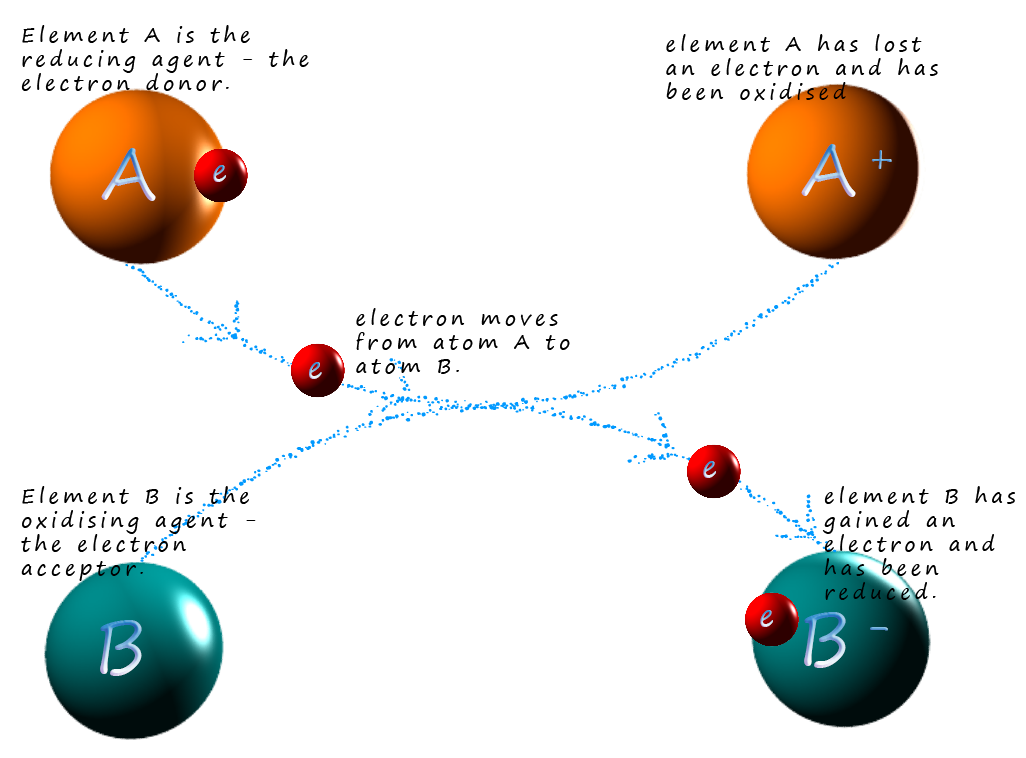
Ionic compounds typically contain metal and non-metal ions. These ions are formed when the metal atoms are oxidised
(lose electrons) and the non-metal atoms are reduced (gain electrons). The
number of electrons lost or gained
by the metal and non-metal atoms is simply the number needed to gain a stable octet of electrons
(from gcse chemistry- 8 electrons in the outer electron shell). For example sodium chloride consists of sodium
ions (Na+) and chloride ions (Cl-). The oxidation number for these two ions is simply the number of
electrons
lost or gained to complete a stable octet of electron. So for sodium its oxidation number
is +1 and for the chloride ion
its oxidation state or number would be -1.
For other ionic compounds such as those which contain a group 2 metal such as Mg or Ca the
oxidation
state of the metal will be +2, for group 3 metals such as Al the oxidation state
is always +3.
Hydrogen usually loses 1 electron in its reactions and so will have an
oxidation number of +1.
However hydrogen can form compounds with metals such as sodium and lithium where it gains an
electron from the metal. This H- ion is called a
hydride ion and it has an oxidation state or oxidation number of -1.
More oxidation numbers
Oxygen usually accepts 2 electrons to complete its outer shell of
electrons and form a stable octet.
This will produce the oxide ion (O2-). Here the
oxygen has an oxidation number of -2.
However oxygen can for example react with the alkali metals to
form compounds where the oxidation state
of the oxygen is -1. These compounds are called metal
peroxides e.g. lithium peroxide (Li2O2) and
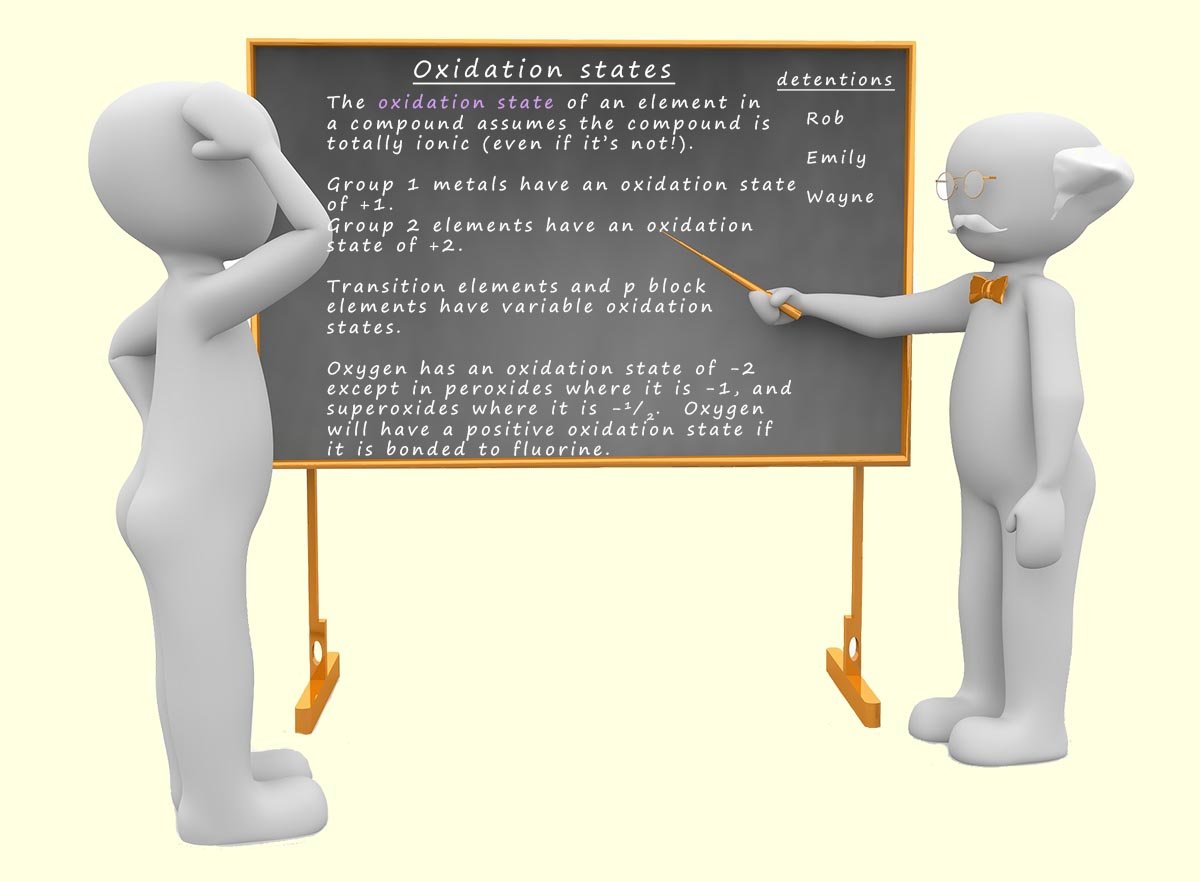 potassium peroxide (K2O2) contain the Na+ and K+ cations. The compounds formed are neutral; that
is they have no charge and since each
metal peroxide contains 2 metal ions each with a positive charge
and there are 2 oxygen ions present each oxygen ion must have a -1 charge or an
oxidation state of -1.
Potassium, rubidium and caesium can also react with oxygen to form metal superoxides (M02). In a superoxide the oxidation
state of the oxygen is -1/2.
potassium peroxide (K2O2) contain the Na+ and K+ cations. The compounds formed are neutral; that
is they have no charge and since each
metal peroxide contains 2 metal ions each with a positive charge
and there are 2 oxygen ions present each oxygen ion must have a -1 charge or an
oxidation state of -1.
Potassium, rubidium and caesium can also react with oxygen to form metal superoxides (M02). In a superoxide the oxidation
state of the oxygen is -1/2.
The halogens
Chlorine and other halogens such as bromine and iodine have only to gain 1 electron to achieve an octet of
electrons so they will have an oxidation
state of -1 unless they is bonded to very electronegative elements such as fluorine or oxygen in which case their
oxidation number can vary.
Oxidation numbers in covalent compounds.
In deciding on oxidation numbers above we assumed that
electrons were transferred from on atom to
another and that ions were produced. However in covalent compounds
the electrons are shared and not transferred.
However recall that oxidation numbers are only used to help us keep track of what
is happening in a chemical reaction. So
we will simply assume or pretend that the covalent compounds are in fact ionic- even though they are NOT!

In working out oxidation numbers for the elements in a covalent compound we will assume that the most
electronegative element in the covalent bond basically has the
electrons in the covalent bond transferred to it.
This will mean that the more electronegative element in the covalent bond will have a
negative oxidation number
and the least electronegative element will have a positive
oxidation number e.g.
Example 1 - What is the oxidation states of the nitrogen and hydrogen atoms in ammonia (NH3)?

- The most electronegative element here is nitrogen and it makes 3 covalent bonds
to the hydrogen atoms. So despite the fact that this is a covalent compound we will assume that the electrons in the covalent bonds are transferred to the most electronegative element, which in this case will be the nitrogen atom. So this means that the nitrogen atom will gain 3 electrons, one electron from each hydrogen atom.
This means the oxidation number of nitrogen will be -3.
- Each hydrogen atom will lose 1 electron
so the oxidation state of hydrogen will be +1.
This makes sense since the ammonia molecule is neutral. The -3
oxidation number of the nitrogen will be
cancelled out by the three +1 oxidation numbers from each hydrogen atom.
Example 2- What is the oxidation number for each atom in a molecule of sulfur dioxide (S02)?
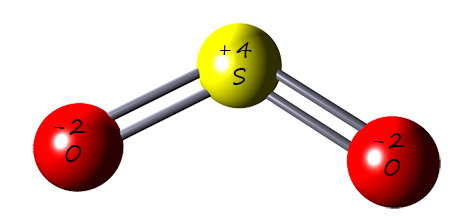
- The most electronegative element is present in this molecule is oxygen and it needs to gain 2
electrons to complete its octet; so it
will gain 2 electrons from the sulfur atom and end up with an
oxidation number of -2.
- The molecule is neutral and since the sulfur atom is bonded to
two oxygen atoms and each one takes 2 electrons then the sulfur will
end up with an oxidation number of +4.
Since the molecule is neutral we can be confident that these oxidation numbers are correct, since 2x the
oxidation number of oxygen added to the oxidation number of the sulfur atom is 0.
Example 3 - What is the oxidation state of each atom in the sulfate ion, SO42-?
- Each oxygen atom will have an oxidation number of -2. Since there are
x4 oxygen atoms this will give a
total of -8.
- The molecule has a charge of -2; so the oxidation state of the sulfur atom must be +6. Since -8+6=2-.
Example 4- What is the oxidation number of chlorine in the ClO3- molecule?
- The oxidation number of the oxygen atom is -2. There are 3 oxygen atoms
giving a total charge of -6.
- The molecule has a charge of -1, so the oxidation number of the chlorine must be +5 since -6+5=-1.
Example 5- What is the oxidation state of aluminium in aluminium oxide (Al2O3)?
- The oxidation state of the oxygen ion will be -2. Since there are
x3 oxide ions this gives a total charge of -6.
- The "molecule" is neutral so the total oxidation number
for the two aluminium ions must be +6. So
simply divide by 2 to get the oxidation number for each aluminium ion, so the answer is +3.
Oxidation numbers and transition metals
The transition metals form a variety of compounds where the metal has variable oxidation states or numbers.
I am sure you will have seen the
names of many transition metals written with the oxidation number of the metal present in Roman numerals e.g.
- iron (III) oxide - here the iron has an oxidation number of +3
- iron(II) oxide - here the iron has an oxidation number of +2
- copper(I) chloride - here the copper has an oxidation number of +1
- copper (II) chloride - here the copper has an oxidation number of +2
You may also see the oxidation state of the metal written in Roman numerals after the name of the compound e.g.
- Copper(II) sulfate pentahydrate (CuSO4·5H2O)- here the copper has an oxidation state of +2.
- potassium dichromate (VI) (Cr2O72-) here the metal chromium has an oxidation number of +6
- potassium manganate (VII) (MnO4-) here the manganese has an oxidation number of +7
The common oxidation states for the first row transition metals are shown
in the table below. The oxidation state of the metal
will depend on the reaction conditions and the reagents used.
| Sc |
Ti |
V |
Cr |
Mn |
Fe |
Co |
Ni |
Cu |
| |
|
|
|
|
|
|
|
+1 |
| |
+2 |
+2 |
+2 |
+2 |
+2 |
+2 |
+2 |
+2 |
| +3 |
+3 |
+3 |
+3 |
+3 |
+3 |
+3 |
|
|
| |
+4 |
+4 |
|
+4 |
|
|
|
|
| |
|
+5 |
|
|
|
|
|
|
| |
|
|
+6 |
+6 |
|
|
|
|
| |
|
|
|
+7 |
|
|
|
|
The lower oxidation states of the transition metals consist of simple
ions such as M2+ and M3+. Transition
metals with a low oxidation number can act as reducing agents
and donate electrons to other substances, e.g.
Fe2+ → Fe3+ + e
Cr2+ → Cr3+ + e
The higher oxidation states for the transition metals are only found
in compounds where the metal is bonded to
a element with a high electronegativity value, such as oxygen e.g.
- The highest oxidation state for the metal vanadium is +5, this is found
for example in the VO2+ ion.
- The highest oxidation state for chromium is +6, this is found for example in the
chromate ion (CrO42-) and dichromate ions
Cr2O72-.
- The highest oxidation state for manganese is +7, this is found for
example in the MnO4- ion.
Ions which contain metals in high oxidation states are good electron
acceptors; that is they are good oxidising agents.
The oxidation states of vanadium
The transition metal vanadium has a wide range of oxidation states ranging from +2, +3, +4 and +5. Each of these
oxidation states
has a different colour. You can view all the different colours of the various oxidation states of vanadium, start by dissolving
the compound ammonium vanadate (V) in
sulfuric acid. This compound has the formula NH4VO3 and contains vanadium ions in the +5
oxidation state, now when it is dissolved in sulfuric acid the vanadate (V) ions are converted into the dioxovanadium ions (VO2+) which
are yellow in colour (see image below), an equation for this reaction is shown below (note that the ammonium ion and hydrogen sulfate ions are spectator ions and for simplicity I have removed them from the equation below):
VO3(aq)- + 2H + ⇌ VO2(aq)+ + H2O(l)
When this yellow solution is shaken with powdered zinc it is reduced
to form blue oxovanadium (IV) ions (VO2+). If more zinc metal is added
then green vanadium (III) ions are formed (V3+(aq)) and if even more zinc is added then it will reduce the
green V3+( ions to form the violet V2+(aq) ion. The zinc is the
reducing agent in
these reactions and supplies all the electrons necessary to
reduce the V5+ ion to the V2+ ion. The zinc itself is
oxidised according to the equation below:
Zn(s) → Zn2+(aq) + 2e
The colour changes are shown in the image below:
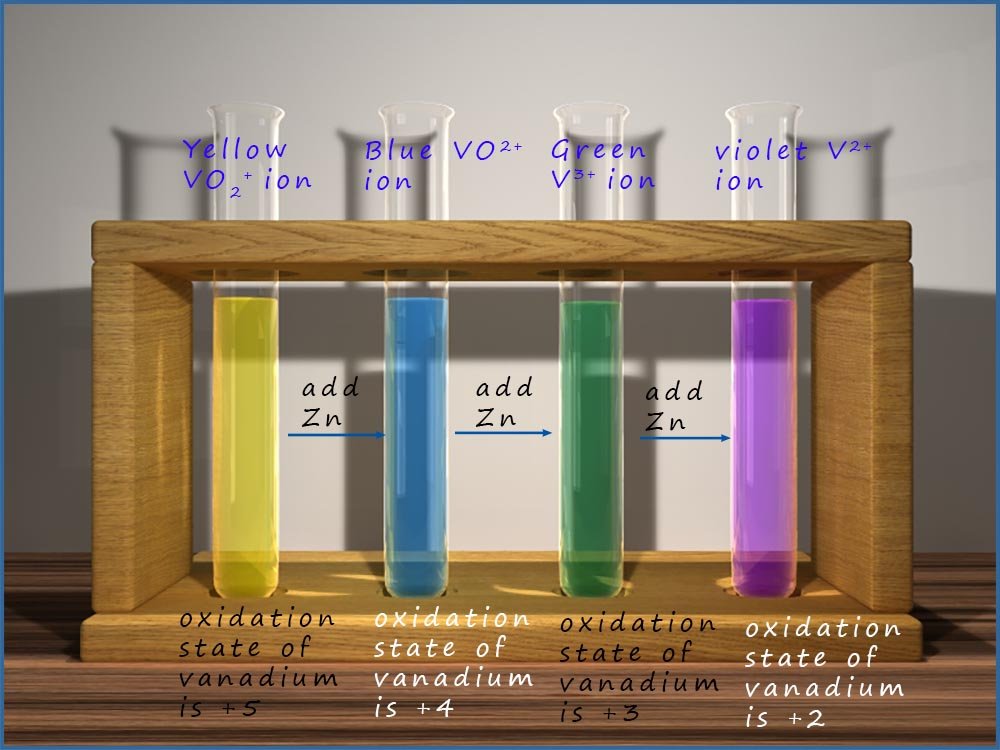
The oxidation states of chromium metal
Chromium metal is another transition metal with variable oxidation states, it has 3 oxidation states: +2, +3 and +6; that is Cr2+, Cr3+ and Cr6+, with the
Cr3+ ion being the most stable. Now chromium metal reacts with concentrated acid in the absence of air to
yield the beautiful blue chromous ion, Cr2+. We can write a simplified equation for this reaction as:
Cr(s) + 2H+ → Cr2+(aq) + H2(g)
Cr2+(aq) ions are good reducing agents and if the above reaction is carried out in the presence of air then
the blue Cr2+(aq) ions are oxidised by the oxygen in the air to form the green Cr3+(aq) ion.
4Cr2+(aq) + O2(g) + 4H+(aq) → 4Cr3+(aq) + 2H2O(l)
The highest oxidation state for chromium is +6 and this is found in two ions, the yellow
chromate ion CrO42- and the orange dichromate ion, Cr2O72- ion.
These two ions are in equilibrium with each other and the concentration of each ion in the equilibrium mixture depends upon the pH of the solution, this is shown by the equation below:
CrO42- + 2H+ ⇌ Cr2O72- + H2O(l)
In basic or alkaline solutions the yellow chromate ion (CrO42-) is the main species present while the addition of
acid to the equilibrium mixture will cause the yellow solution to
turn orange as the concentration of the dichromate ion
(CrO42-) increases.
The Cr2O72- ion in acidic conditions is an excellent oxidising agent while the chromate ion, present in basic solutions
is a much weaker oxidising agent.
This is shown in the image below:
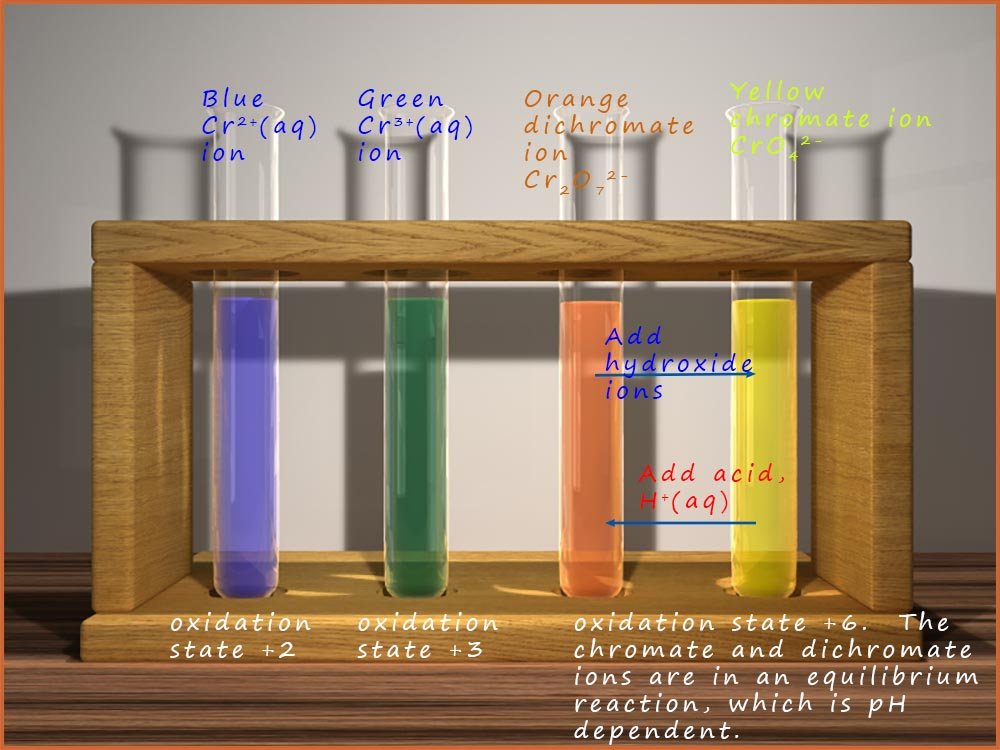
Key Points
- The oxidation number for an atom in an element is 0.
- Oxidation is the loss of electrons or the addition of oxygen or the removal of hydrogen from a substance.
- Reduction is the gain of electrons or the removal oxygen from a substance.
- The oxidation number or state is simply the number of electrons lost or gained by an atom. When working out the oxidation
number of an element in a compound we assume the bonding within the compound is completely ionic- even if it's not. Oxidation numbers
are only used to help us follow the reaction taking place. They do not represent the actual charges present on atoms, unless the
compound is completely ionic.
- Cations, ions with positive oxidation numbers have lost electrons while anions, that is ions with negative charges have gained electrons.
- Reducing agents are electron donors and oxidising agents are
electron acceptors.
Practice questions
Next

 potassium peroxide (K2O2) contain the Na+ and K+ cations. The compounds formed are neutral; that
is they have no charge and since each
metal peroxide contains 2 metal ions each with a positive charge
and there are 2 oxygen ions present each oxygen ion must have a -1 charge or an
oxidation state of -1.
Potassium, rubidium and caesium can also react with oxygen to form metal superoxides (M02). In a superoxide the oxidation
state of the oxygen is -1/2.
potassium peroxide (K2O2) contain the Na+ and K+ cations. The compounds formed are neutral; that
is they have no charge and since each
metal peroxide contains 2 metal ions each with a positive charge
and there are 2 oxygen ions present each oxygen ion must have a -1 charge or an
oxidation state of -1.
Potassium, rubidium and caesium can also react with oxygen to form metal superoxides (M02). In a superoxide the oxidation
state of the oxygen is -1/2.





